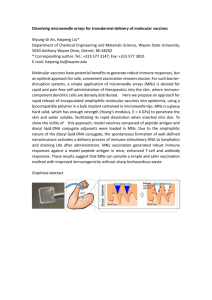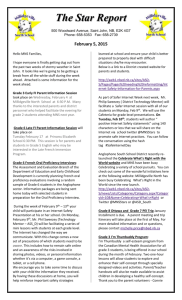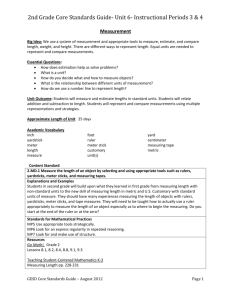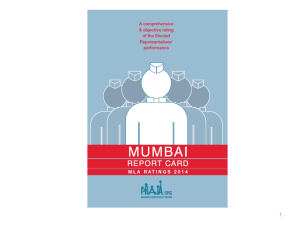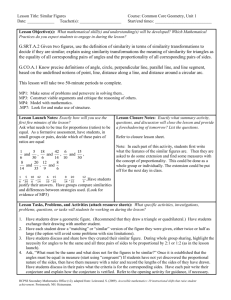1 Municipal - County Medical Needs Shelter SOG_FINAL
advertisement
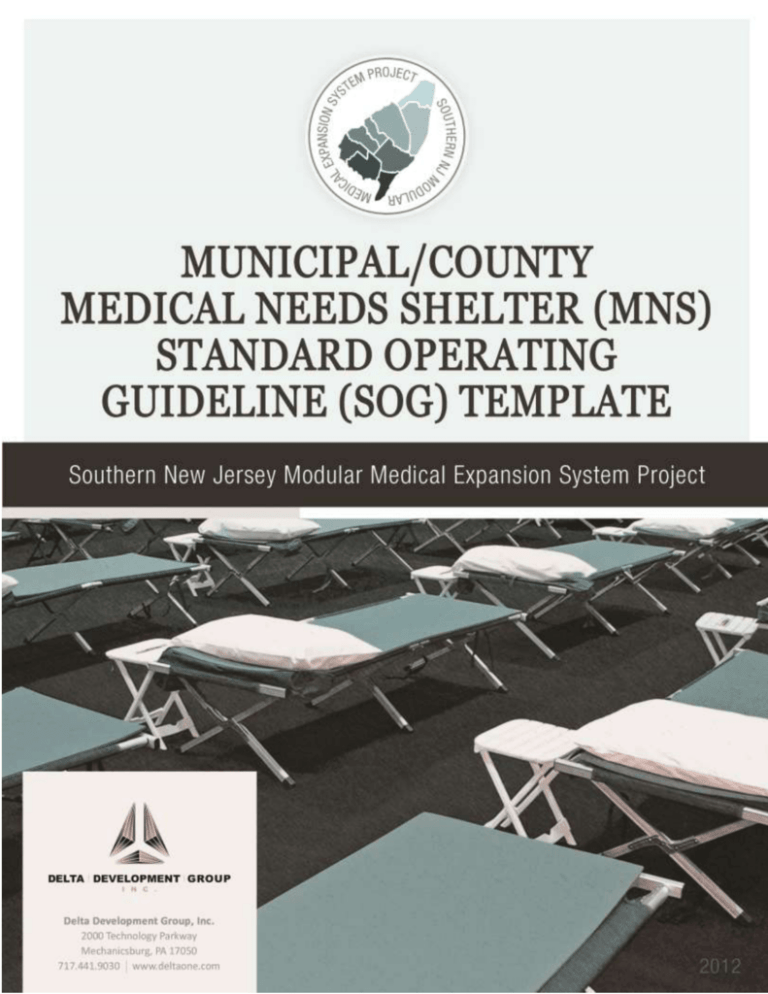
How to Use this Template This template has been developed to assist county and municipal governments in the development of a Medical Needs Shelter (MNS) Standard Operating Guideline (SOG). It serves as a tool to help emergency managers establish the framework and procedures for effective management of the MNS. This template can be used to operate a MNS that is either a stand-alone facility or one that is co-located within a Community Shelter. While there are slight differences in the operation of the two types of MNS, this template provides guidance that is applicable to both. Communities must decide which model is the most appropriate for their community based upon community needs and the resources at their disposal. This guide represents a general approach to how the MNS will operate. To tailor this document to your needs, begin by substituting your agency-specific information in the bracketed spaces. Practices relative to how your agency operates or other best practices should be substituted or added where applicable. Paragraphs that do not apply to your jurisdiction may be removed. Once the MNS SOG is completed, a robust training and exercise program should be developed and implemented. Page 1 of 14 MNS SOG July 2012 Table of Contents: 1. Background ....................................................................................................................... 3 2. Purpose............................................................................................................................... 3 3. Planning Assumptions ...................................................................................................... 3 4. Concept of Operations ...................................................................................................... 3 5 Roles and Responsibilities .............................................................................................. 12 6 Plan Maintenance............................................................................................................ 12 Page 2 of 14 MNS SOG July 2012 1. Background 1.1 2. Purpose 2.1 3. 4. This Standard Operating Guideline (SOG) contains information outlining the development, organization, and coordination for the activation, operation, and demobilization of a Medical Needs Shelter (MNS) as the result of a natural or technological disaster. The purpose of a MNS is to provide austere, short-term supportive medical care during a natural or technological disaster when the evacuee is displaced from their home or specialized facility and cannot be accommodated at a general population shelter due to their medical needs. Planning Assumptions 3.1 The local government officials or Governor has declared a State of Emergency. 3.2 The establishment and use of a MNS should be a last resort after a declared State of Emergency. 3.3 An increasing number of the general population are sustained at home using medical equipment and skilled care for respiratory assistance, feeding, and medications. 3.4 Natural or technological disasters may affect the operation of the specialized medical equipment or the ability to get medical care to the evacuee (patient). 3.5 An evacuation of the public has occurred or may occur, causing persons with medical needs to seek shelter. The evacuation order is expected to require absence from home for more than eight (8) hours. 3.6 During an evacuation incident, hospitals and long-term care facilities may not be an appropriate location for the care of this patient subset due to available space and level of care considerations as well as the need for beds to be made available to the maximum extent possible. 3.7 Acute care facilities may not be able, and should not plan to accommodate surge of nonacute evacuees during an emergency. In the event that non-acute evacuees spontaneously or erroneously report to a hospital, the hospital will perform an initial Medical Screening Exam (MSE). Once the MSE has been performed, the hospital will refer the evacuee (patient) to the nearest MNS if applicable. 3.8 Local emergency medical services are experiencing increased call volumes due to extended travel times. 3.9 A number of people with medical needs have arrived at the Community Shelter and/or the [municipality/county/agency] is receiving requests to shelter people with medical needs. Concept of Operations 4.1 General Page 3 of 14 MNS SOG July 2012 4.2 4.3 4.1.1 The MNS is designed to serve as a transitional care area with capability for a short-term stay with all evacuees (patients) then being returned to their place of residence or temporary housing accommodations. 4.1.2 Each MNS equipment cache is designed to accommodate 25 evacuees (patients). 4.1.3 Maintaining operations for additional hours is optional depending on the continued availability of staffing and logistical resources. Organization 4.2.1 The [county emergency management/public health agency] oversees the MNS in accordance with the municipal/county Emergency Operations Plan (EOP), Emergency Support Function (ESF) #6 – Mass Care, Housing, & Human Resources. 4.2.2 The [municipality/county/agency name] MNS is supported by several agencies and organizations that will provide services. Their roles and responsibilities are outlined in Section 5 of this SOG. 4.2.3 The [municipality/county/agency] will activate ESF #6 and establish command and control staff at the Emergency Operations Center (EOC) to direct the activities of one or more MNS. Additional ESFs will be activated to support the MNS based upon the demands of the incident. 4.2.4 The [municipality/county/agency] has plans for managing spontaneous volunteers. Volunteers at the MNS will be from the Medical Reserve Corps (MRC) [MRC name/other] and will be appropriately credentialed by [credentialing authority] staff. 4.2.5 The staffing and organization chart for the [county name] MNS is described in Appendix 3. Facility 4.3.1 The [municipality/county/agency] can accommodate opening and staffing of up to [#] MNS concurrently. 4.3.2 Primary and secondary facilities are pre-identified and have been evaluated as appropriate locations for a MNS. Site-specific information is provided in Appendix 4. 4.3.3 The [municipality/county/agency] has an executed Memorandum of Understanding (MOU) with the facility where the MNS will be located. 4.3.4 Facility agreements are maintained by the [municipality/county/agency]. Copies of the facility agreements are provided in Appendix 5. 4.3.5 A MNS can be expanded to accommodate additional evacuees (patients) depending on facility size and the availability of additional MNS equipment caches or resource support from local agencies. Facilities and their potential capacity are provided in Appendix 4. Page 4 of 14 MNS SOG July 2012 4.3.6 4.4 4.5 At a minimum, a facility should have 2000 sq. ft. of space available for a clinical area with sufficient additional space for management and support activities. Support Services 4.4.1 When the MNS is co-located with a Community Shelter, the agency managing the Community Shelter will provide basic shelter services to all residents, including evacuee registration, dietary needs, and sanitation services. This includes support for evacuees with access and functional needs. 4.4.2 When the MNS is located independently, [agency name] is responsible for providing basic shelter services to all residents, including evacuee registration, dietary needs, and sanitation services. See Appendix 6 for a listing of supporting organizations and agencies. Activation 4.5.1 The [municipality/county/agency] will determine appropriateness of a MNS activation based upon the emergency conditions, agency recommendations, and available resources. 4.5.2 Recommendations to activate a MNS should be made by [municipality/county/agency] to [municipality/county/agency]. The request should include the proposed location and potential number of beds needed. 4.5.3 Upon receiving the request(s) to activate one or more MNS, [municipality/county/agency] will coordinate with [municipality/county/agency] to designate the MNS site(s) to be used. 4.5.4 The [municipality/county/agency] will designate the MNS Site Coordinator(s). 4.5.5 The MNS Site Coordinator, a representative from the [municipality/county/agency], a Community Shelter representative (if MNS is in a co-located facility), and a facility representative conduct a walk-through of the facility. The MNS Site Coordinator should take photos of the facility and should note pre-existing damage to the facility. Facility survey forms are available in Appendix 8. 4.5.6 The [county] Office of Emergency Management (OEM) shall coordinate for the MNS equipment cache trailer to be transported to the identified MNS location and shall coordinate the acquisition of additional MNS resources as indicated. 4.5.7 Upon deployment of the MNS equipment cache trailer, [county OEM] will notify the appropriate Medical Coordination Center (MCC) that the trailer is in use, the location of the trailer, and the Point of Contact (POC) for the trailer. 4.5.8 The [county/municipality] EOC will be activated with [ESF #6] designated to lead the MNS operations. 4.5.9 If the anticipated need for the MNS beds exceeds the capabilities of the county to meet the needs, the [county OEM] will request mutual aid from neighboring counties, the region, or the state to obtain additional support. Page 5 of 14 MNS SOG July 2012 4.5.10 The [municipality/county/agency] staff shall meet the trailer at the MNS location and set up the shelter in the identified location within the selected facility. 4.5.11 The MNS Site Coordinator will communicate with the [county/municipality] EOC when the MNS is prepared to receive evacuees (patients). 4.6 Notification 4.6.1 4.6.2 4.7 Upon activation of the MNS, [municipal/county OEM/EOC/public health] will do the following: A. Notify [MRC/Community Emergency Response Teams (CERT)] to activate their respective staffs. B. Notify local Emergency Medical Services (EMS) to notify them that a MNS will be established and that transportation support may be necessary. C. Notify the South Region MCC that a MNS has been activated and provide a situation report as well as a POC. D. Notify NJ Department of Health and Senior Services (DHSS) to inform them of the opening of the MNS and, if necessary, request appropriate waivers to include, but not be limited to, the following: EMS to allow option of transporting evacuee (patient) directly to a MNS EMS to allow Basic Life Support (BLS) units to transport evacuees (patients) that would otherwise require Advanced Life Support (ALS) intervention E. Notify [county/municipality] Public Information Officer (PIO) that a shelter is open. A general public announcement of the location of the MNS may be made at the discretion of the [county/municipal OEM]. F. Notify NJ OEM to inform them of a MNS activation. G. Notify other response stakeholders at the discretion of the [county/municipal OEM]. See Appendix 6 for contact information. Triage and Case Definition 4.7.1 A MNS is designed to care for people with health or medical needs that may require assistance with activities of daily living beyond those typically classified as persons with access and functional needs. This may include those persons that require in-home medical care and or/assistance with medical treatments. A MNS should not be used for individuals requiring acute medical treatment. Individuals requiring such acute medical treatment will be transported to an appropriate facility by EMS. EMS will be advised of MNS triage criteria. This criteria can be found in Appendix 2. Page 6 of 14 MNS SOG July 2012 4.7.2 The Triage Officer triages evacuees (patients) upon arrival at the MNS. Triage criteria are explained in Appendix 2. Triage forms are located in Appendix 8. Disposition includes: A. Admission to the MNS (Tier 2). B. Admission to a general population shelter (Tier 1). C. Transport to the hospital (Tier 3). 4.7.3 Examples of acceptable evacuees (patients) for MNS services are not allinclusive. The MNS Triage Officer will consult with the MNS Site Coordinator when in doubt. The MNS Triage Officer may seek advice with a county, regional, or state medical director (person issuing standing orders with regard to MNS operations) to make final admission decisions. 4.7.4 Evacuees (patients) with acute psychological disorders, except for those that are suicidal, homicidal, or that otherwise present a danger to themselves or others, may be admitted to the MNS at the discretion of the Triage Officer and the MNS Site Coordinator. Persons with access and functional needs may also be allowed into the MNS at the discretion of the MNS Site Coordinator, provided that required resources are present and available. Evacuees (patients) may arrive by referral from a hospital after a medical screening exam, another shelter, or local EMS. 4.7.5 4.7.6 4.7.7 Efforts should be made by family or transportation providers to inform the evacuee’s (patient’s) caregiver that any evacuee-specific supplies, medications, or nourishment must be brought to the MNS by the caregiver. See Appendix 10 for a sample media release. 4.8 Caregivers/Family Members/Pets 4.8.1 4.8.2 Caregivers/family members are encouraged to accompany evacuee (patient) to the MNS whenever possible. Each evacuee (patient) may be limited to one adult caregiver/family member while at the MNS based upon available space and resources at the MNS. 4.8.3 The Triage Officer gives each caregiver/family member a wristband or other means of visible identification with their name written on it for identification. 4.8.4 Any minors accompanying an evacuee (patient) may stay at the MNS at the discretion of the MNS Site Coordinator. 4.8.5 Caregivers are encouraged to assist MNS staff in providing care to the evacuee (patient) that fall under their purview or who are family members. 4.8.6 Registration staff members are to ensure that space is provided in the shelter for the caregiver(s) of the evacuee (patient) admitted to the MNS. Page 7 of 14 MNS SOG July 2012 4.8.7 If the Community Shelter is not co-located within the same facility as the MNS, the MNS Site Coordinator, at their discretion, arranges for the transportation of caregivers/family members between the general population shelter and the MNS and/or for sleeping arrangements at the facility in which the MNS is located, if available. 4.8.8 Only service animals certified as such are allowed in the shelter. 4.9 Command and Control 4.9.1 The [ESF #6 Coordinator] in the [county/municipal EOC] is responsible for directing the deployment, set up, and evacuee (patient) care for all MNS opened under this plan. 4.9.2 The MNS Site Coordinator is responsible for the operation of the MNS. 4.9.3 Organization Chart MNS Site Coordinator Administrative Section Chief Operations Section Chief Logistics Section Chief Administrative Support Case Manager Resource Manager Security Officer(s) 4.9.4 Triage Officer (RN or higher) RN (1) LPN (1) Evacuee (Patient) Care Technician (3) Pharmacy Mental Health Counselor EMS Transport Crew Clergy All media inquiries will be referred to [municipality/county/agency]. 4.10 Communications 4.10.1 The MNS Site Coordinator establishes and maintains communications with the [ESF #6] desk at the [municipal/county EOC]. 4.10.2 The primary method of communication between the [municipal/county EOC] and the MNS is [phone/cellular/radio]. 4.10.3 The secondary method of communication between the [municipal/county EOC] and the MNS is [phone/cellular/radio]. 4.11 Registration 4.11.1 Co-location with a Community Shelter 4.11.1.1 Community Shelter registration staff will register evacuees (patients) triaged and directed to the MNS. 4.11.2 When not co-located with a Community Shelter Page 8 of 14 MNS SOG July 2012 4.11.2.1 The [county public health/MRC/CERT] will conduct registration duties. 4.11.2.2 Evacuees (patients) not accepted into the MNS will be referred to the appropriate Community Shelter. 4.11.3 Registration forms are to be created for each evacuee (patient). The MNS registration forms can be found in Appendix 8. 4.11.4 Evacuees (patients) are also to be fitted with a wristband or other means of visible identification with their name, date of birth, and the MNS site written on it. 4.12 Medical Care and Physician Medical Direction 4.12.1 The [municipality/county] will designate a Medical Director to oversee the MNS operations. 4.12.2 The MNS staff will provide care under written guidelines. 4.12.3 When necessary medical care exceeds written protocols, shelter staff will consult with the county medical director for specific physician orders. 4.12.4 The patient care technician to evacuee (patient) ratio should be approximately 10:1, but can be increased should the situation necessitate/require it. 4.12.5 The registered nurse to evacuee (patient) ration should be approximately 20:1, but can be increased should the situation necessitate/require it. 4.12.6 In the case of life-threatening emergencies within the MNS, the site EMS crew should be alerted to take initial lifesaving actions and local transport EMS should be notified through 9-1-1. 4.13 Infection Control and Sanitation 4.13.1 All staff members are to be trained in the proper handling of evacuees (patients) and supplies. 4.13.2 Universal precautions are to be followed at all times unless directed otherwise when additional protective measures are needed. 4.13.3 The MNS shelter staff will provide just-in-time training for staff without prior universal precautions training. 4.13.4 The MNS will be disinfected at regular intervals to prevent the spread of bacteria and other infectious agents. 4.13.5 The MNS will be maintained through regular cleaning, medical waste disposal, and trash removal. 4.14 Security 4.14.1 The [law enforcement agency] oversees the MNS security operations as the lead agency to maintain a secure shelter and assist in maintaining order. Page 9 of 14 MNS SOG July 2012 4.14.2 All rooms that contain sensitive equipment (such as computers or records) and pharmaceutical supplies will remain locked during shelter operations. The MNS Coordinator will provide for access to the appropriate personnel. 4.14.3 Only staff with visible identification approved by [municipal/county OEM/public health/MRC] are allowed to work in the MNS. The MNS staff members are to wear identification badges at all times. 4.14.4 The MNS staff members should minimize access to the MNS by other persons sheltered at the same location unless they are a family member or caregiver to an evacuee (patient). The MNS staff will ensure that all visitors in the MNS are provided with a wristband or other visible means of identification. 4.15 Credentialing of the MNS Staff 4.15.1 The [municipality/county/agency] is responsible for verifying the credentials of the MNS staff and maintaining a list of credentials for the MNS staff. 4.16 Evacuee (Patient) Counseling 4.16.1 Each MNS will have an assigned counselor to provide mental health, behavioral, and/or social counseling as needed. 4.16.2 Each MNS site should designate space within the MNS, but separate from the main patient area, for evacuees (patients) who are experiencing behavioral health issues. This area may also be used to treat staff experiencing similar behavioral health issues. 4.16.3 Counselors from the [agency/organization] will provide counseling services and support to the [county/municipality] MNS. 4.16.4 Counselors are to maintain observation of the main evacuee (patient) area in order to intervene proactively with potential behavioral/mental health issues. 4.17 Pharmacy Area 4.17.1 A secure pharmacy location will be identified for the storage of evacuee (patient) medication and other supplies. Whenever possible, a nurse’s office with a lockable door and a refrigerator is to be used. 4.17.2 The pharmacy area will utilize appropriate inventory control procedures to ensure accountability for medications. Medication inventory shall be taken upon receipt, and each time medication is issued from pharmacy stock or evacuees’ (patients’) individual medications. 4.17.3 The MNS staff members are to remain vigilant to prevent access to the pharmacy area. Security personnel are assigned to monitor access to the pharmacy area. 4.18 Logistics 4.18.1 The Logistics Section Chief is initially deployed to the MNS for the set-up and to establish all logistical support in preparation to receive evacuees. Page 10 of 14 MNS SOG July 2012 4.18.2 The Logistics Section Chief establishes a liaison with the facility owner to ensure that facility mechanical systems are operating appropriately. 4.18.3 The Logistics Section Chief will be responsible for keeping aisles and evacuation routes clear. 4.18.4 The Logistics Section Chief will oversee medical waste disposal and trash removal and assure that the MNS is kept clean and sanitized. 4.18.5 See Appendix 6 for a list of MNS support service providers. 4.18.6 Logistics staff tracks all supplies and equipment utilized from the MNS equipment cache or other resources on appropriate forms. The MNS logistics and administrative staff members retain all requisitions, supply lists, purchase orders, and receipts. 4.18.7 Special requests for supplies or equipment shall go through the MNS Site Coordinator to the [ESF #6] desk at the [municipal/county EOC]. 4.18.8 The [county/municipality/agency] will arrange for food services within the MNS. 4.18.9 When the MNS is co-located with a Community Shelter, the MNS Site Coordinator will confer with the Community Shelter manager to house evacuees (patients) that only require limited treatment or services and can reasonably be managed within the Community Shelter. The MNS Site Coordinator may determine that a first aid station may be the most appropriate means to treat evacuees (patients) not within the MNS. 4.18.10 The Logistics Section Chief is responsible for the accounting and placement of all equipment and supplies during the demobilization processes. 4.19 Mutual Aid and Regional Response 4.20.1 Refer to the Southern NJ regional plan (under development) for mutual aid procedures. 4.20.2 Develop mutual aid procedures. 4.20 Demobilization 4.20.1 The MNS Site Coordinator, in consultation with [municipal/county/agency] will make the determination to demobilize the MNS operations. 4.20.2 The MNS Site Coordinator will work with the MNS Case Manager to ensure continuity of care and transport of any remaining evacuees to their homes or appropriate care facilities. 4.20.3 The [county OEM/public health] will inform the Community Shelter staff, municipal OEMs, and other agencies as required. 4.20.4 The [county PIO] or Joint Information Center (JIC) (if activated) will be notified. 4.20.5 All unexpended supplies and equipment are returned to the MNS equipment cache trailer or to its source and will be documented by the Logistics Section Chief or appointee of the [county/municipal OEM]. Page 11 of 14 MNS SOG July 2012 4.20.6 The [municipality/county/agency] will replenish equipment used during the MNS operations and will be documented by the Logistics Section Chief or the appointee of the [county/municipal Emergency Coordinator]. 4.20.7 Copies of evacuee care records are retained by the [municipality/county/agency] that provided medical care to the evacuee (patient) for a period of no less than seven years and will be copied and forwarded to the caregiver upon written request by the evacuee (patient). 4.20.8 The MNS Site Coordinator, a representative from the [municipality/county/agency], a Community Shelter representative (if MNS is in a co-located facility), and a facility representative conduct a walk-through of the facility. The MNS Site Coordinator should take photos of the facility and complete MNS Form 11 located in Appendix 8. 4.20.9 The MNS Site Coordinator completes a damage report as necessary and provides copy to the [municipal/county OEM/public health]. 4.20.10 Restoration of the facility to pre-event status is the responsibility of [agency name]. 4.20.11 Reimbursement for damages to facility is to be addressed in individual facility MOUs with [agency name]. 5 Roles and Responsibilities 5.1 Municipal/County Office of Emergency Management 5.2 Municipal/County Department of Public Health 5.3 Municipal/County Department of Aging 5.4 Municipal/County Department of Mental Health 5.5 Municipal/County Department of Transportation 5.6 Municipal/County Department of Public Works 5.7 Municipal/County Emergency Medical Services 5.8 Municipal/County Fire/Rescue Services 5.9 Municipal/Law Enforcement 6 5.10 American Red Cross 5.11 Hospital 5.12 MCC 5.13 Others Plan Maintenance 6.1 The [municipal/county OEM/public health/responsible agency] maintains this SOG as part of ESF #6 plans and procedures. Page 12 of 14 MNS SOG July 2012 6.2 6.3 7 All agencies with a role and responsibility identified in this SOG are to review the SOG annually. Contact information shall be updated at least annually by [municipal/county OEM/public health/responsible agency]. 6.4 Changes in SOG and contact information are to be provided to [municipal/county OEM/public health]. 6.5 The SOG should be reviewed annually and revised every three years. Training, Exercise, and Evaluation 7.2 The [municipal/county OEM/public health] identifies training needs with other agencies participating in the MNS operations. 7.3 The [municipal/county OEM/public health] arranges for training and/or exercise on an annual basis. 7.4 The [municipal/county OEM/public health] conducts critiques of actual event or exercise to determine and correct, if possible, program deficiencies. Page 13 of 14 MNS SOG July 2012
